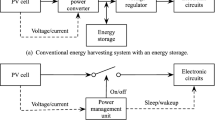Abstract
A new energy harvesting circuit for battery-less IoT beacon tags is developed herein to maximize power conversion efficiency as well as high throughput power with a wide input–output range. This design energy harvest (EH) circuit incorporates a charge pump (CP) with shoot-through current suppression, a body selector circuit, a maximum power point tracking circuit (MPPT), a timing control circuit, a hysteresis control circuit and a low dropout regulator. Also in this MPPT circuit is a gated clock tuned in a self-adaptive fashion to match the input impedance of the EH circuit to the output impedance of the photovoltaic (PV) panel, thus achieving successfully maximum power point. The circuit is implemented in an integrated chip in an area of 1.2 mm2 via the TSMC 0.18 process. Experiments on the chip are conducted and the results show that the input voltage range is allowed from 0.55 to 1.7 V to effectively harvest the solar power from a flexible dye-sensitized solar cell. The achieved peak power conversion efficiency (PCE) is 77% at the input power of 52 μW. For a wide range of lighting luminance (300–1300 lx,) the achieved average PCE is more than 70%. The achieved wide input–output range and the maximum throughput power of 200 μW is much larger than others reported, while the 77% of PCE is close to that best power conversion efficiency reported.



















Similar content being viewed by others
References
Carreon-Bautista S, Eladawy A, Mohieldin AN, Sanchez-Sinencio E (2014) Boost converter with dynamic input impedance matching for energy harvesting with multi-array thermoelectric generators. IEEE Trans Ind Electron 61(10):5345–5353
Esram T, Chapman PL (2007) Comparison of photovoltaic array maximum power point tracking techniques. IEEE Trans Energy Convers 22(2):439–449
Gasnier P, Willemin J, Boisseau S, Despesse G, Condemine C, Gouvernet G, Chaillout J-J (2014) An autonomous piezoelectric energy harvesting IC based on a synchronous multi-shot technique. IEEE J Solid-State Circuits 49(7):1561–1570
Goerlich K (2016) Live business: the importance of the internet of things,” live business, internet of things, knowledge networks, Redefining Resource Management, May 05, 2016
Huang P-H, Lin H, Lin Y-T (2006) A simple subthreshold CMOS voltage reference circuit with channel- length modulation compensation. IEEE Trans Circuits Syst II Express Briefs 53(9):882–885
Kim J, Mok P, Hoi Lee (2005) Switching noise and shoot-through current reduction techniques for switched-capacitor voltage doubler. IEEE J Solid-State Circuits 40(5):1136–1146
Kim J, Kim J, Kim C (2011) A regulated charge pump with a low-power integrated optimum power point tracking algorithm for indoor solar energy harvesting. IEEE Trans Circuits Syst I Express Briefs 58(12):802–806
Kim H, Min Y, Jeong C, Kim K, Kim C, Kim S (2013) A 1-mW solar-energy-harvesting circuit using an adaptive MPPT with a SAR and a counter. IEEE Trans Circuits Syst II Express Briefs 60(6):331–335
Kim J, Mok P, Kim C (2015) A 0.15 V input energy harvesting charge pump with dynamic body biasing and adaptive dead-time for efficiency improvement. IEEE J Solid-State Circuits 50(2):414–425
Lee H, Mok PKT (2005) Switching noise and shoot-through current reduction techniques for switched-capacitor voltage doubler. IEEE J Solid-State Circuits 40(5):1136–1146
Li X, Tsui C, Ki W (2012) Solar energy harvesting system design using re-configurable charge pump. In: 2012 IEEE faible tension faible consommation, Paris, 2012, pp 1–4
Liu X, Sanchez-Sinencio E (2015) An 86% efficiency 12 µW self-sustaining PV energy harvesting system with hysteresis regulation and time-domain MPPT for IOT smart nodes. IEEE J Solid-State Circuits 50(6):1424–1437
Men G-Y, Cheng Y-P, Chao PC-P, Yang C-C, Pribadi EF (2016) A charge pump with MPPT circuit employed in batteryless photovoltaic IoT tags. ASME 2016 Conference on Information Storage and Processing Systems, pp V001T09A003
Rawy K, Yoo T, Kim TT (2018) An 88% efficiency 0.1–300 μW energy harvesting system with 3-D MPPT using switch width modulation for IoT smart nodes. IEEE J Solid-State Circuits 53(10):2751–2762
Reinisch H, Wiessflecker M, Gruber S, Unterassinger H, Hofer G, Klamminger M, Pribyl W, Holweg G (2011) A multifrequency passive sensing tag with on-chip temperature sensor and off-chip sensor interface using EPC HF and UHF RFID technology. IEEE J Solid-State Circuits 46(12):3075–3088
Shao H, Tsui C, Ki W-H (2009) The design of a micro power management system for applications using photovoltaic cells with the maximum output power control. IEEE Trans Very Large Scale Integration Syst (VLSI) 17(8):1138–1142
Yao R, Wang W, Farrokh-Baroughi M, Wang H, Qian Y (2013) Quality-driven energy-neutralized power and relay selection for smart grid wireless multimedia sensor based IoTs. IEEE Sensors J 13(10):3637–3644
Acknowledgements
This study is supported by Ministry of Science and Technology, Taiwan grant No. MOST 106-2634-F-009-001 -CC2, MOST 107-2221-E-009 -166 -MY2, MOST 107-2218-E-009 -006 -, MOST107-3017-F009-003, MOST 107-2622-E-009 -025 -CC2, MOST 108-2823-8-009 -002 -, and MOST 108-2623-E-009 -004 –D. It was also supported in part by the Novel Bioengineering and Technological Approaches to Solve Two Major Health Problems in Taiwan sponsored by the Taiwan Ministry of Science and Technology Academic Excellence Program under Grant Number: MOST 108-2633-B-009-001. This work was financially supported by the “Center for Intelligent Drug Systems and Smart Bio-devices (IDS2B)” from The Featured Areas Research Center Program within the framework of the Higher Education Sprout Project by the Ministry of Education (MOE) in Taiwan.
Author information
Authors and Affiliations
Corresponding author
Additional information
Publisher's Note
Springer Nature remains neutral with regard to jurisdictional claims in published maps and institutional affiliations.
Rights and permissions
About this article
Cite this article
Yang, CC., Pandey, R., Tu, TY. et al. An efficient energy harvesting circuit for batteryless IoT devices. Microsyst Technol 26, 195–207 (2020). https://doi.org/10.1007/s00542-019-04544-7
Received:
Accepted:
Published:
Issue Date:
DOI: https://doi.org/10.1007/s00542-019-04544-7




